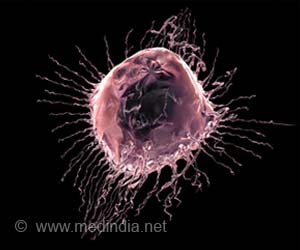A study in the journal Physics Today suggests that low-intensity electric fields can disrupt the division of cancer cells and slow the growth of brain tumours.
A study in the journal Physics Today suggests that low-intensity electric fields can disrupt the division of cancer cells and slow the growth of brain tumours. These findings raise hopes that electric fields could become a new weapon for stalling the progression of cancer.
In the studies, the research team uses alternating electric fields that jiggle electrically charged particles in cells back and forth hundreds of thousands of times per second. The electric fields have an intensity of only one or two volts per centimeter. Such low-intensity alternating electric fields were once believed to do nothing significant other than heat cells. However, in several years' worth of experiments, the researchers have shown that the fields disrupt cell division in tumor cells placed on a glass dish (in vitro).After intensively studying this effect in vitro and in laboratory animals, the researchers started a small human clinical trial to test its cancer-fighting ability. The technique was applied to ten human patients with recurrent glioblastoma multiforme (GBM), a form of brain cancer with a very low survival rate.
All the patients had their earlier tumors treated by other methods, but the cancer had started to recur in all cases. Fitting the patients with electrodes that applied 200 kHz electric fields to the scalp at regular intervals for up to 18 hours per day, the researchers observed that the brain tumors progressed to advanced stages much slower than usual (taking a median time of 26 weeks), and sometimes even regressed.
The patients also lived considerably longer, with a median survival time of 62 weeks. While no control group existed, the results compared favorably to historical data for recurrent GBM, in which the time for tumor progression is approximately 10 weeks and the typical survival time is 30 weeks. In addition, 3 of the 10 patients were still alive two years after the electrode therapy started. These results were announced in a recent issue of The Proceedings of the National Academy of Sciences.
The Physics Today article explains these results in terms of the physical mechanisms that enable the electric fields to affect dividing cancer cells. In vitro, the electric fields were seen to have two effects on the tumor cells.
First, they slowed down cell division. Cells that ordinarily took less than an hour to divide were still not completely divided after three hours of exposure to an electrical field of 200 kHz. Another group consisting of Luca Cucullo, Damir Janigro and their colleagues at the Cleveland Clinic, slowed cell division by applying electric fields with a much lower frequency just 50 Hz. In addition, this protocol demonstrated the ability to decrease the intrinsic drug resistance of the cells.
Advertisement
The second effect of the 200 kHz fields is that they sometimes disintegrated the daughter cells just before they split off from their partners. The dividing cells sometimes destruct because a high-electric-field region develops between the two daughter cells. This leads to a large slope, or gradient, in the electric field from each daughter cell to this region. This gradient may rip organelles (cell structures) and macromolecules (such as proteins) from the scaffolding of the cells.
Advertisement
Based on the success of their initial human study, the researchers are working on another human clinical trial, this time with a control group receiving chemotherapy. The researchers are also investigating the possibility of combining the electric-field therapy with low-dose chemotherapy.
Source-Eurekalert
LIN/B









